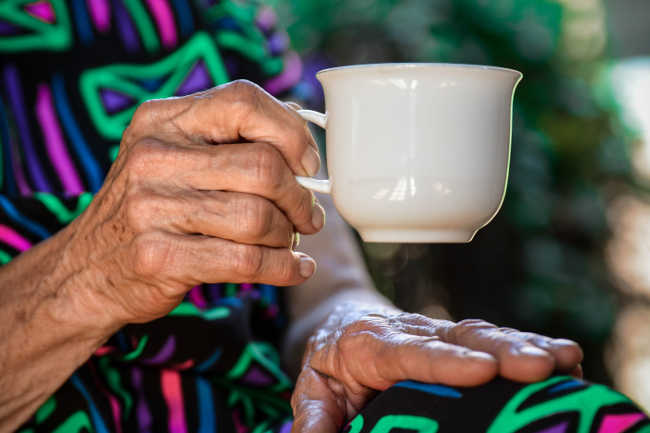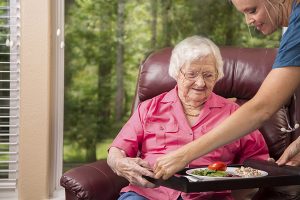
Are you evaluating your options to care for elderly parents? We understand that starting the conversation about new living options for aging parents isn’t easy.
When your mom doesn’t think she needs to move, it can feel impossible to make any progress.
However, the level of care your loved one needs will most likely determine which of the following four living options is right for your mom or dad. Consider these questions as you read about available options to care for elderly parents:
- Does your loved one have a spouse who can support their needs?
- Were they diagnosed with a chronic illness like Alzheimer’s?
- Do they have an acute condition requiring short-term care?
- What is your parent’s financial situation?
- Which option is best suited for your family situation?
Learn about four living options for aging parents and decide which one best serves their needs and provides you with the most peace of mind.
4 Living Options for Aging Parents
1. Remotely Monitor Older Adults Living at Home
The desire of most adults aged 50 and older is to age in their current house and community. You may not be surprised by that statement if you’ve already had a conversation with your aging mother or father who refuses to move. While you may be concerned about the safety of your loved one living alone, you can take steps to monitor them at home.
Remote home monitoring systems for seniors are one way to keep an eye on your aging parents without moving them. Now, you’ll want to get permission before you install any kind of technology in your parent’s home, but it could be a compromise for you both.
You’ll also need to decide if a remote monitoring system provides you with enough peace of mind and protection for your loved one. However, even with home monitoring, aging in place without the support of a spouse, family member, or caregiver may not be the best option.
Don’t worry; we’ve got a few more options for you to evaluate.
2. Move Your Elderly Loved One in with You
If you’re wondering how to care for the elderly in your own home, this option is for you. You could decide to move your aging loved one in with you and become a family caregiver. Now, this option requires a lot from you as the caregiver. For instance, you will need to modify your home to ensure it safely accommodates your loved one:
- Add railings around the house, especially in bathrooms.
- Widen doorways to accommodate wheelchairs.
- Install safety locks on specific cabinets with medications.
- Furnish a bedroom on the first floor to prevent your loved one from walking upstairs.
Caring for a loved one in your home is a big decision that involves an ongoing commitment. Some children feel they owe a debt to their parents and have no choice but to care for them. If you’re not sure who’s responsible for providing long-term care for elderly parents, read our article, “Should children take care of their elderly parents?”
Maybe you already know moving a loved one in with you isn’t a feasible option. Let’s look at another alternative living option for seniors.
3. Independent Living Communities
Independent living communities for seniors are housing developments designed especially for adults aged 55 and over. The retirement housing in these communities can vary from standalone homes to apartment-style living. These housing communities foster social interaction among older adults with aging-friendly architecture (e.g., more compact).
Independent living communities offer amenities, such as a fitness center, swimming pool, tennis courts, and sometimes laundry services. One benefit of independent living is the community-wide interest groups and activities catered to older adults.
Independent living is best for adults who do not require long-term care services and can safely live alone. Long-term care services can include activities of daily living (ADLs) such as dressing, bathing, and using the bathroom.
4. In-home Caregiving
Due to COVID-19, many parents are homeschooling their children, working from home, and managing new family dynamics. Caring for an aging loved one on top of an already full house isn’t always a plausible or even possible option. Additionally, not everyone is capable of adequately caring for older adults as their personal needs grow.
In-home care is one of the best options for senior care because it enables older adults to safely age in place. Your loved one will receive necessary and basic elderly care, such as support with ADLs. Caregivers help aging adults in more than just a physical way by becoming elderly companions, too, which is an easily overlooked benefit of in-home caregiving.
Professional caregivers offer family caregivers respite, accommodate seniors’ unique care requirements, and provide peace of mind to the adult children of aging parents. You won’t need to check a monitor, modify your home and lifestyle, or house hunt for the right independent living community.
How to Get Help Taking Care of Elderly Parents
A dedicated caregiver is one of the best options for elderly care at home because they integrate into a senior’s life instead of disrupting it. If you want to explore care options for elderly parents and get help looking after elderly parents, contact Stowell Associates.
Our expert care managers can help you evaluate your options to care for elderly parents and provide ongoing support to your family. Contact our care team to discuss the elder care options available for your loved one by calling one of our four locations:
- Milwaukee: 414-963-2605
- Kenosha: 262-287-0805
- Racine: 262-880-5864
- Waukesha: 262-955-1756
To find more resources for caring for aging parents, visit our blog for caregivers and family members.












